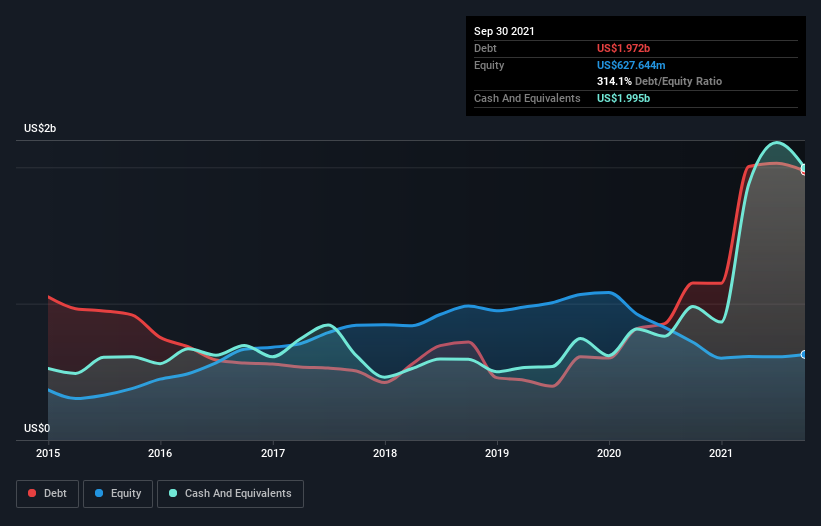
Some say volatility, rather than debt, is the best way to think about risk as an investor, but Warren Buffett famously said that 'Volatility is far from synonymous with risk.' When we think about how risky a company is, we always like to look at its use of debt, since debt overload can lead to ruin. We note that Hawaiian Holdings, Inc. (NASDAQ:HA) does have debt on its balance sheet. But the real question is whether this debt is making the company risky.
When Is Debt A Problem?
Debt and other liabilities become risky for a business when it cannot easily fulfill those obligations, either with free cash flow or by raising capital at an attractive price. Ultimately, if the company can't fulfill its legal obligations to repay debt, shareholders could walk away with nothing. However, a more common (but still painful) scenario is that it has to raise new equity capital at a low price, thus permanently diluting shareholders. Of course, the upside of debt is that it often represents cheap capital, especially when it replaces dilution in a company with the ability to reinvest at high rates of return. The first step when considering a company's debt levels is to consider its cash and debt together.
View our latest analysis for Hawaiian Holdings
What Is Hawaiian Holdings's Debt?
You can click the graphic below for the historical numbers, but it shows that as of September 2021 Hawaiian Holdings had US$1.97b of debt, an increase on US$1.15b, over one year. However, its balance sheet shows it holds US$1.99b in cash, so it actually has US$22.9m net cash.

A Look At Hawaiian Holdings' Liabilities
We can see from the most recent balance sheet that Hawaiian Holdings had liabilities of US$1.23b falling due within a year, and liabilities of US$3.11b due beyond that. Offsetting these obligations, it had cash of US$1.99b as well as receivables valued at US$149.6m due within 12 months. So it has liabilities totalling US$2.20b more than its cash and near-term receivables, combined.
The deficiency here weighs heavily on the US$1.14b company itself, as if a child were struggling under the weight of an enormous back-pack full of books, his sports gear, and a trumpet. So we'd watch its balance sheet closely, without a doubt. After all, Hawaiian Holdings would likely require a major re-capitalisation if it had to pay its creditors today. Hawaiian Holdings boasts net cash, so it's fair to say it does not have a heavy debt load, even if it does have very significant liabilities, in total. There's no doubt that we learn most about debt from the balance sheet. But ultimately the future profitability of the business will decide if Hawaiian Holdings can strengthen its balance sheet over time. So if you want to see what the professionals think, you might find this free report on analyst profit forecasts to be interesting.
In the last year Hawaiian Holdings had a loss before interest and tax, and actually shrunk its revenue by 11%, to US$1.3b. We would much prefer see growth.
So How Risky Is Hawaiian Holdings?
Although Hawaiian Holdings had an earnings before interest and tax (EBIT) loss over the last twelve months, it generated positive free cash flow of US$136m. So although it is loss-making, it doesn't seem to have too much near-term balance sheet risk, keeping in mind the net cash. Given the lack of transparency around future revenue (and cashflow), we're nervous about this one, until it makes its first big sales. To us, it is a high risk play. The balance sheet is clearly the area to focus on when you are analysing debt. However, not all investment risk resides within the balance sheet - far from it. These risks can be hard to spot. Every company has them, and we've spotted 2 warning signs for Hawaiian Holdings (of which 1 makes us a bit uncomfortable!) you should know about.
If you're interested in investing in businesses that can grow profits without the burden of debt, then check out this free list of growing businesses that have net cash on the balance sheet.
If you're looking to trade Hawaiian Holdings, open an account with the lowest-cost platform trusted by professionals, Interactive Brokers.
With clients in over 200 countries and territories, and access to 160 markets, IBKR lets you trade stocks, options, futures, forex, bonds and funds from a single integrated account.
Enjoy no hidden fees, no account minimums, and FX conversion rates as low as 0.03%, far better than what most brokers offer.
Sponsored ContentValuation is complex, but we're here to simplify it.
Discover if Hawaiian Holdings might be undervalued or overvalued with our detailed analysis, featuring fair value estimates, potential risks, dividends, insider trades, and its financial condition.
Access Free AnalysisThis article by Simply Wall St is general in nature. We provide commentary based on historical data and analyst forecasts only using an unbiased methodology and our articles are not intended to be financial advice. It does not constitute a recommendation to buy or sell any stock, and does not take account of your objectives, or your financial situation. We aim to bring you long-term focused analysis driven by fundamental data. Note that our analysis may not factor in the latest price-sensitive company announcements or qualitative material. Simply Wall St has no position in any stocks mentioned.
Have feedback on this article? Concerned about the content? Get in touch with us directly. Alternatively, email editorial-team (at) simplywallst.com.
About NasdaqGS:HA
Hawaiian Holdings
Through its subsidiary, Hawaiian Airlines, Inc., engages in the scheduled air transportation of passengers and cargo.
Slightly overvalued very low.
Market Insights
Community Narratives




